Chapter: Cryptography and Network Security Principles and Practice : One Symmetric Ciphers : Block Cipher Operation
XTS-AES Mode For Block-Oriented Storage Devices
XTS-AES MODE FOR BLOCK-ORIENTED STORAGE DEVICES
NIST
is currently in the process of approving an additional block cipher mode of
operation, XTS-AES. This mode is also an IEEE standard, IEEE Std 1619-2007,
which was developed by the IEEE Security
in Storage Working Group (P1619). The standard
describes a method of encryption for data stored in sector-based devices where the threat model
includes possible access
to stored data by the adversary.
The
XTS-AES mode is based on the concept of a tweakable block cipher, introduced in
[LISK02]. The form of this concept used in XTS-AES was first described in
[ROGA04]. The standard has received widespread industry support.
Storage
Encryption Requirements
The requirements for encrypting stored
data, also referred
to as “data at rest”
differ somewhat from those for transmitted data. The P1619 standard was
designed to have the following characteristics:
1.
The ciphertext is freely available for
an attacker. Among the circumstances that lead to this situation:
a.
A group of users has authorized access
to a database. Some of the records in the database are encrypted so
that only specific users can successfully read/write
them. Other users can retrieve an
encrypted record but are unable to read it without the key.
b.
An unauthorized user manages to gain access
to encrypted records.
c.
A data disk or laptop
is stolen, giving
the adversary access
to the encrypted data.
2.
The data layout is not changed on the
storage medium and in transit. The
encrypted data must be the same size as the plaintext
data.
3.
Data are accessed
in fixed sized blocks,
independently from each other.That is, an authorized user may access
one or more blocks in any order.
4.
Encryption is performed in 16-byte blocks, independently from other blocks (except the last two plaintext blocks of a sector, if its size is not a multiple
of 16 bytes).
5.
There are
no other metadata used, except the location of the data blocks within the whole data set.
6.
The same plaintext is encrypted
to different ciphertexts at different
locations, but
always to the same ciphertext when written to the same location again.
7.
A standard
conformant device can be constructed for decryption of data encrypted by another standard
conformant device.
The P1619 group considered some of the existing modes of operation
for use with
stored data. For CTR mode, an adversary with write access to the encrypted
media can flip any bit of the plaintext simply by flipping
the corresponding ciphertext bit.
Next, consider
requirement 6 and the use of CBC.
To enforce the requirement that the same plaintext
encrypt to different ciphertext in different locations, the IV could be derived from the sector
number. Each sector
contains multiple blocks.
An adversary with read/write access to the encrypted disk can copy a ciphertext sector from one position
to another, and an application reading the sector off the new loca- tion will still get the same
plaintext sector (except perhaps the first 128 bits). For example, this means
that an adversary that is allowed
to read a sector from the sec- ond position but not the first can
find the content of the sector in the first position by manipulating the ciphertext. Another weakness is that an adversary can flip any bit of the plaintext by flipping the
corresponding ciphertext bit of the previous block, with the side-effect of “randomizing” the previous block.
Operation
on a Single Block
Figure
6.9 shows the encryption and decryption of a single block. The operation
involves two instances of the AES algorithm
with two keys. The following
parame- ters are associated with the algorithm.
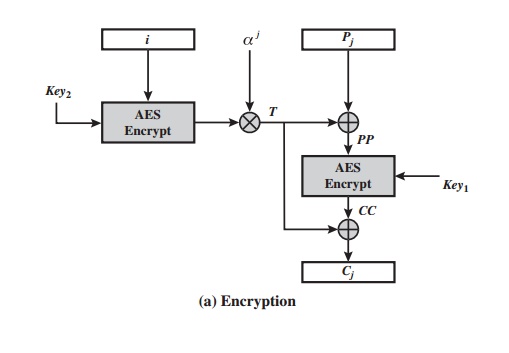
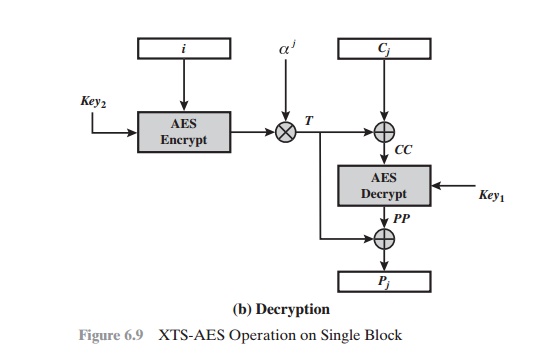
Key The 256 or 512 bit XTS-AES
key; this is parsed as a concatenation of two fields of equal size
called Key1
and Key2,
such that Key = Key1 7 Key2.
Pj The jth block
of plaintext. All blocks except
possibly the final
block have a length
of 128 bits. A plaintext data unit, typically a disk sector,
consists of a sequence of plaintext blocks P1, P2, Á , Pm.
Cj The jth block
of ciphertext. All blocks except
possibly the final
block have a length
of 128 bits.
j The sequential number of the 128-bit block inside the data unit.
i The value of the 128-bit tweak. Each data unit
(sector) is assigned a tweak
value that is a nonnegative integer. The tweak
values are assigned consecutively, starting from an arbitrary nonnegative integer.
a A primitive element of GF(2128) that corresponds to polynomial x
(i.e.,
0000 Á 0102).
aj a multiplied
by itself j times, in GF(2128).
Ⓧ Bitwise XOR.
Ⓢ Modular multiplication of two polynomials with binary coefficients modulo x128 + x7 + x2 + x
+ 1. Thus,
this is multiplication in GF(2128).
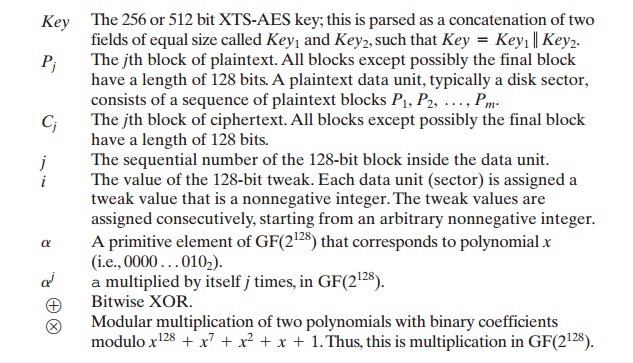
In
essence, the parameter j functions
much like the counter in CTR mode. It
assures that if the same plaintext block appears at two different positions
within a data unit, it will encrypt
to two different ciphertext blocks. The parameter i functions much like a nonce at the data unit level. It
assures that, if the same plaintext block appears at the same position in two different data units,
it will encrypt
to two differ- ent ciphertext blocks. More generally, it assures that the same plaintext data unit will encrypt to two different
ciphertext data units for two different data unit positions.
The
encryption and decryption of a single block can be described as

To
see that decryption recovers the plaintext, let us expand the last line of both
encryption and decryption. For encryption, we have
C = CC Ⓧ T = E(K1, PP) Ⓧ
T = E(K1, P Ⓧ T) Ⓧ T
and
for decryption, we have
P = PP Ⓧ T = D(K1, CC) Ⓧ
T = D(K1, C Ⓧ T) Ⓧ T
Now,
we substitute for C:
P = D(K1, C Ⓧ T) Ⓧ T
= D(K1, [E(K1, P Ⓧ T) Ⓧ T] Ⓧ T) Ⓧ T
= D(K1, E(K1, P Ⓧ T)) Ⓧ T
= (P Ⓧ T) Ⓧ T = P
Operation
on a Sector
The plaintext of a sector or data unit is organized into blocks of 128 bits. Blocks are labeled P0, P1, Á , Pm. The last block my be null or may contain from 1 to 127 bits. In other words, the input to the XTS-AES algorithm consists of m 128-bit blocks and possibly a final partial block.
For encryption and decryption, each block is treated independently and encrypted/decrypted as shown in Figure 6.9. The only exception occurs when the last block has less than 128 bits. In that case, the last two blocks are encrypted/decrypted using a ciphertext-stealing technique instead of padding. Figure 6.10 shows the scheme. Pm-1 is the last full plaintext block, and Pmis the final plaintext block, which contains s bits with 1 … s … 127. Cm-1 is the last full ciphertext block, and Cmis the final ciphertext block, which contains s bits.
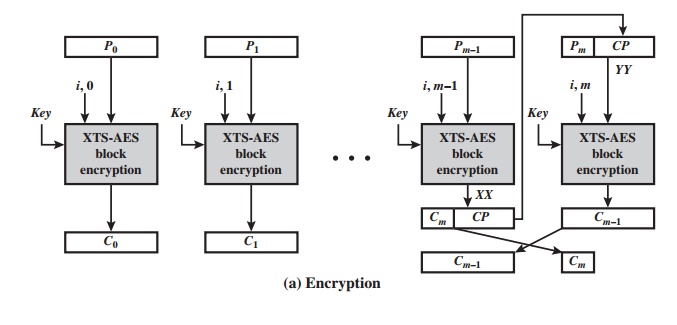
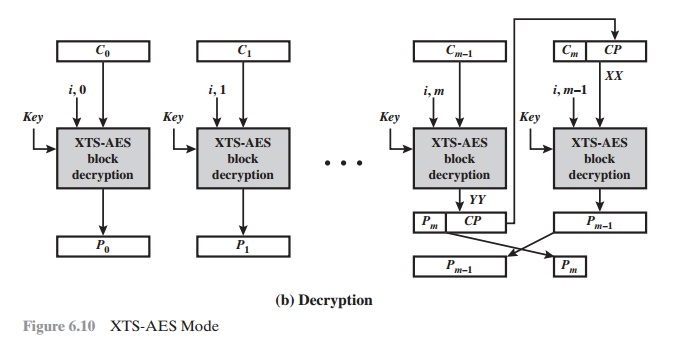
Let
us label the block encryption and decryption algorithms of Figure 6.9 as
Block
encryption: XTS-AES-blockEnc(K, Pj, i,
j) Block decryption:
XTS-AES-blockDec(K, Cj, i, j)
Then,
if the final block is null, XTS-AES mode is defined as follows:
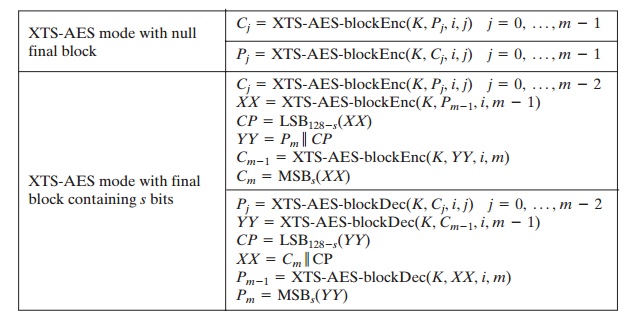
As can be seen, XTS-AES mode, like CTR mode, is suitable for parallel operation.
Because there is
no chaining, multiple blocks can be encrypted or decrypted
simultaneously. Unlike CTR mode, XTS-AES mode includes a nonce (the parameter i) as well as a counter (parameter j).
Related Topics